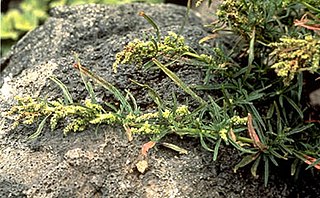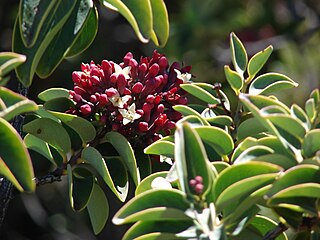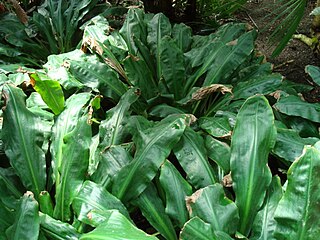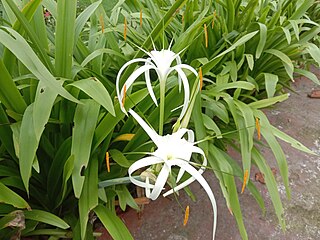
Tradescantia is a genus of 85 species of herbaceous perennial wildflowers in the family Commelinaceae, native to the Americas from southern Canada to northern Argentina, including the West Indies. Members of the genus are known by many common names, including inchplant, wandering jew, spiderwort, dayflower and trad.

Macadamia is a genus of four species of trees in the flowering plant family Proteaceae. They are indigenous to Australia, native to northeastern New South Wales and central and southeastern Queensland specifically. Two species of the genus are commercially important for their fruit, the macadamia nut. Global production in 2015 was 160,000 tonnes. Other names include Queensland nut, bush nut, maroochi nut, bauple nut and, in the US, they are also known as Hawaii nut. It was an important source of bushfood for the Aboriginal peoples.

Dendrobium crumenatum, commonly called pigeon orchid, or 木石斛 is an epiphytic orchid in the family Orchidaceae and is native to Asia, Southeast Asia, New Guinea and Christmas Island. It has two rows on leaves along its pseudobulb and relatively large but short-lived, strongly scented white flowers. It usually grows in exposed positions in lowland rainforest and coastal scrub.

Arundina graminifolia is a species of orchid and the sole accepted species of the genus Arundina. This tropical Asiatic genus extends from Myanmar, India, Sri Lanka, Nepal, Thailand, Vietnam, the Ryukyu Islands, Malaysia, Singapore, China to Indonesia, the Philippines and New Guinea. It has become naturalized in Réunion, Fiji, French Polynesia, Micronesia, the West Indies, Costa Rica, Panama, Belize, and Hawaii. It is also called bamboo orchid.

Commelinaceae is a family of flowering plants. In less formal contexts, the group is referred to as the dayflower family or spiderwort family. It is one of five families in the order Commelinales and by far the largest of these with about 731 known species in 41 genera. Well known genera include Commelina (dayflowers) and Tradescantia (spiderworts). The family is diverse in both the Old World tropics and the New World tropics, with some genera present in both. The variation in morphology, especially that of the flower and inflorescence, is considered to be exceptionally high amongst the angiosperms.

Amaranthus brownii was an annual herb in the family Amaranthaceae. The plant was found only on the small island of Nihoa in the Northwestern Hawaiian Islands, growing on rocky outcrops at altitudes of 120–215 m (394–705 ft). It was one of nine species of Amaranthus in the Hawaiian Islands, as well as the only endemic Hawaiian species of the genus. It is now considered extinct.

Ochrosia is a genus of flowering plants, first described in 1789. It is in the family Apocynaceae, native to Southeast Asia, Australia, and various islands of the Indian and Pacific Oceans.
- Ochrosia ackeringae(Teijsm. & Binn.) Miq. – Indonesia, Philippines, Papuasia, Christmas Island
- Ochrosia acuminataTrimen ex Valeton – Sulawesi
- Ochrosia alyxioidesGuillaumin – Vanuatu
- Ochrosia apoensisElmer – Luzon, Mindanao
- Ochrosia balansae(Guillaumin) Baill. ex Guillaumin – New Caledonia
- Ochrosia basistaminaHendrian – Sulawesi
- Ochrosia bodenheimarumGuillaumin – Vallée de la Toutouta in New Caledonia
- Ochrosia borbonicaJ.F.Gmel. – Mauritius + Réunion; naturalized in Guangdong
- Ochrosia brevitubaBoiteau – New Caledonia
- Ochrosia brownii(Fosberg & Sachet) Lorence & Butaud – Nuku Hiva in Marquesas
- Ochrosia citrodoraK.Schum. & Lauterb. – New Guinea
- Ochrosia coccinea(Teijsm. & Binn.) Miq. – Maluku, Sulawesi, New Guinea, Solomon Islands; naturalized in Guangdong
- Ochrosia comptaK.Schum., Hōlei – Hawaii
- Ochrosia ellipticaLabill. – Lord Howe Island, Queensland, New Caledonia, Vanuatu, Nauru; naturalized in Guangdong + Taiwan
- Ochrosia fatuhivensisFosberg & Sachet – Fatu Hiva in Marquesas but extinct
- Ochrosia ficifolia(S.Moore) Markgr. – New Guinea
- Ochrosia glomerata(Blume) F.Muell. – Borneo, Sulawesi, Philippines, Maluku, New Guinea, Solomon Islands
- Ochrosia grandifloraBoit. – New Caledonia
- Ochrosia haleakalaeH.St.John, Hōlei – Maui + island of Hawaiʻi in Hawaiian Islands
- Ochrosia hexandraKoidz. – Kazan-retto
- Ochrosia inventorumL.Allorge – New Caledonia
- Ochrosia iwasakiana(Koidz.) Koidz. ex Masam.
- Ochrosia kauaiensisH.St.John, Hōlei – Kauaʻi in Hawaiian Islands
- †Ochrosia kilaueaensisH.St.John, Hōlei – island of Hawaiʻi in Hawaiian Islands, but extinct
- Ochrosia kilneriF.Muell. – Queensland
- Ochrosia lifuanaGuillaumin – Loyalty Islands + Isle of Pines in New Caledonia
- Ochrosia mariannensisA.DC. – Mariana Islands
- Ochrosia mianaBaill. ex Guillaumin – New Caledonia
- Ochrosia minima(Markgr.) Fosberg & Boiteau – Queensland, Papua New Guinea
- Ochrosia moorei(F.Muell.) F.Muell. ex Benth. – Queensland, New South Wales
- Ochrosia mulsantiiMontrouz. – New Caledonia
- Ochrosia nakaiana(Koidz.) Koidz. ex H.Hara – Ogasawara-shoto
- Ochrosia newellianaF.M.Bailey – Queensland
- Ochrosia novocaledonicaDäniker – New Caledonia
- Ochrosia oppositifolia(Lam.) K.Schum. – Seychelles, Chagos Islands, Sri Lanka, Maldive Islands, Andaman & Nicobar Islands, Thailand, Vietnam, W Malaysia, Indonesia, Papuasia, Samoa, Tonga, Tuvalu, Vanuatu, Wallis & Futuna, French Polynesia, Line Islands, Micronesia
- Ochrosia poweriF.M.Bailey – Queensland, New South Wales
- Ochrosia sciadophyllaMarkgr – Bismarck Archipelago, Solomon Islands
- Ochrosia sevenetiiBoiteau – New Guinea
- Ochrosia silvaticaDäniker – New Caledonia
- Ochrosia solomonensis(Merr. & L.M.Perry) Fosberg & Boiteau – Solomon Islands
- Ochrosia syncarpaMarkgr. – Bali, Lombok, Timor, Flores
- Ochrosia tahitensisLaness. ex Pichon – Tahiti
- Ochrosia tenimberensisMarkgr. – Tanimbar Islands
- Ochrosia nukuhivensisFosberg & Sachet = Rauvolfia nukuhivensis(Fosberg & Sachet) Lorence & Butaud
- Ochrosia sandwicensisA.DC. = Rauvolfia sandwicensisA.DC.
- Ochrosia tuberculata(Vahl) Pichon = Rauvolfia sandwicensisA.DC.

Palisota is a genus of plant in family Commelinaceae, first described in 1828. It is native to sub-Saharan Africa.

Santalum haleakalae, known as Haleakala sandalwood or ʻIliahi in Hawaiian, is a species of flowering tree in the sandalwood family, that is endemic to the islands of Maui, Lanai, and Molokai in the Hawaiian Islands, part of the United States. It grows in subalpine shrublands at elevations of 1,900 to 2,700 m, especially on the slopes of Haleakalā.

Commelina benghalensis, commonly known as the Benghal dayflower, tropical spiderwort, or wandering Jew, kanshira in Bengali, is a perennial herb native to tropical Asia and Africa. It has been widely introduced to areas outside its native range, including to the neotropics, Hawaii, the West Indies and to both coasts of North America. It has a long flowering period, from spring to fall in subtropical areas, and throughout the year closer to the equator. It is often associated with disturbed soils.

Heliotropium curassavicum, commonly called salt heliotrope, a species of flowering plant in the borage family (Boraginaceae). It is native to much of the Americas, from Canada to Argentina, including the West Indies and Hawaii. It can be found as an introduced, and sometimes invasive, species in Africa, Asia, Australia, and Europe. It thrives in salty soils, such as beach sand, alkali flats, and salt marshes. It is often found in disturbed coastal sites.

Epipremnum is a genus of flowering plants in the family Araceae, found in tropical forests from China, the Himalayas, and Southeast Asia to Australia the western Pacific. They are evergreen perennial vines climbing with the aid of aerial roots. They may be confused with other Monstereae such as Rhaphidophora, Scindapsus and Amydrium.

Palisota barteri is a species of plant in the Commelinaceae family, described in 1862. It is native to western + central Africa.

Tradescantia spathacea, also called the oyster plant, boatlily or 'Moses-in-the-cradle', is an herb in the Commelinaceae family which was first described in 1788. It is native to Belize, Guatemala, and southern México and is widely cultivated as an ornamental houseplant; it has become naturalized in parts of coastal Southern California, Florida, Hawaii, Louisiana, Texas, and various Pacific and Indian Ocean islands.

Hymenocallis littoralis, commonly known as the beach spider lily, is a species of plant in the amaryllis family Amaryllidaceae. It is native to warmer coastal regions of Latin America and a widely cultivated and naturalized plant in many tropical countries.
Clover yellow vein virus (ClYVV) is a plant pathogenic virus in the genus Potyvirus and the virus family Potyviridae. Like other members of the Potyvirus genus, ClYVV is a monopartite strand of positive-sense, single-stranded RNA surrounded by a capsid made for a single viral encoded protein. The virus is a filamentous particle that measures about 760 nm in length. This virus is transmitted by several species of aphids in a nonpersistent manner and by mechanical inoculation.

Murdannia is a genus of annual or perennial monocotyledonous flowering plants in the family Commelinaceae.
Palisota flagelliflora is a plant species endemic to Cameroon. It grows on the ground in secondary tropical forests.
















